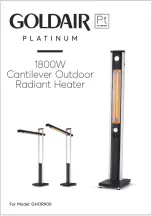
www.dimplex.com
2
Wiring Diagrams
!
nOTe:
it is only necessary to remove the knockout(s)
that will feed the power supply wiring, keeping in mind
the heater mounting location and supply wire location in
the wall.
Secure a pedestal to each end of the heater bottom with
4.
#8 screws provided, aligning the back and front edges of
the pad with the heater. This will align the supply entry
knockout with opening in the pedestal pad.
!
nOTe:
Units longer than 4 feet will be provided with 3
or more pedestals. The extra pedestals should be used
to support the middle of the heater.
place heater on the pedestal base(s) and tighten all
5.
screws.
!
nOTe:
The height of the heater can be adjusted on
the pedestal to aid in leveling the heater by loosening
the securing bolt at the side of the pedestal.
!
nOTe:
Bottom air inlet heaters must be mounted a
minimum of 2” from finished floor.
Remove the terminal box cover and proceed to wiring
6.
instructions.
Figure 1
Wiring instructions
Run branch circuit wiring of proper voltage and wire size
1.
to the location of the terminal box of the heater. (See
above)
!
nOTe:
supply wire entry is commonly made into one
heater. Through wiring (factory furnished) can be used
for connection to adjacent heaters.
Recommended minimum supply wire sizes are listed in the
table below:
mAximum WATTS per circuiT uSinG 75 °c Wire
(cOpper Wire)
Rough in
Wire size
120V 208V 240V 277V 347V 480V 600V
14
1440 2496 2880 3324 4164 5760
7200
12
1920 3328 3840 4432 5552 7680
9600
10
2880 4992 5760 6648 8328 11520 14400
Wire heaters and controls in accordance with the
2.
appropriate wiring diagram.
!
nOTe:
sample wiring diagrams are provided beside.
Wrap the supply ground wire around the green painted
3.
ground screw & tighten.
!
nOTe:
When heaters are mounted end to end, remove
the finished end plate, install a chase nipple and locknut
in the terminal box to ensure grounding continuity and to
protect the wiring.
Where headers are spaced apart, remove the finishing
end plate, and use rigid conduit (provided by customer) for
through wiring and ground continuity. Do not exceed the
allowable number of conductors allowed by the National
Electric Code.





















